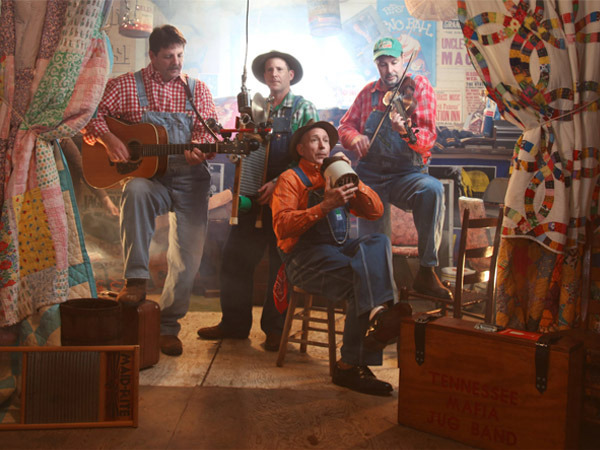Jug bands got their name from using instruments that were either homemade or household items such as a jug. They originated in the South in the 19th century in Louisville, KY, were made up predominately of African-American musicians and were in their heyday from the 1890s to the Great Depression.

The bands spread throughout towns along the Mississippi and Ohio River, frequently performing on riverboats. Their improvisational style added to the popularity of ragtime and blues.
This type of music, or rather this instrumentation, was more than just a fad. Instruments were made out of common items: jugs, combs, gourds, stovepipes, metal pie plates, washboards, spoons, and old guitars. When children blow air across the opening of a glass cola bottle, they are doing a variation of playing a jug. The pitch changes depending on how much air they are blowing and the tension in their lips. This is the same principle as playing the trombone and other instruments where pitch relies on lip movement.
Small gourds were commonly used as maracas and large gourds formed the body of a homemade guitar or mandolin. Small gourds are still used as instruments. The neck of an old guitar was fastened to the gourd for the strings. Pieces of tin pipe, call a stovepipe, were also played by blowing air while changing the tension in the lips. This caused the pipe to resonate.
Metal pie plates were used as a drum or tambourine when hit by hand or with a mallet. The sound created by blowing on a comb and paper was similar to a kazoo. Playing the spoons required skill to hold two spoons in one hand, creating various rhythms.
Musicians in jug bands, regardless of their selected instrument, had to have a strong sense of melodic and rhythmic improvisation. Like all music ensembles, whether classical or jazz, they had to be able to work together and listen to each other.
Jug bands made their first recordings in the 1920s. Within a few years, major cities besides Louisville had their own jug bands: cities like Memphis, Atlanta, Cincinnati, to name a few. Recordings dropped during the Great Depression, as did their popularity, although they did not disappear completely. These informal, improvisational bands are credited with influencing rock and roll. Several of the early rock bands had lead performers who had been in jug bands. Jerry Garcia of the Grateful Dead was in Mother McCree’s Uptown Jug Champions in 1964.
Even though jug bands started out in urban African-American areas, they were also popular in rural white areas. Their revival in the 1950s attested to that. Jug band music was included in Emmet Otter’s Jug-Band Christmas, a children’s television special broadcast in 1977, with music by Paul Williams.
There are several annual jug band festivals throughout the United States. One of the oldest ones is the annual Battle of the Jug Bands held in Minneapolis, MN. Started in 1980, this festival has approximately 35 bands competing from all over the country. It is held every year after the Super Bowl and the grand prize is the “Coveted Hollywood Waffle Iron” trophy.
Another major festival is the Sutter Creek Jug Band Festival, held in Sutter Creek, CA. This area was part of California’s gold rush and is near the Shenandoah Valley.
Jug bands today play a combination of folk music, blues, and jazz. They combine homemade instruments with guitars, banjos, and other handheld instruments. The bands have not only influenced jazz and rock musicians, but also illustrate the possibilities of homemade instruments. Jug bands have a secure place in American and music history and are still making music today.
